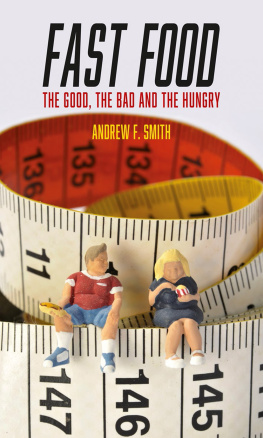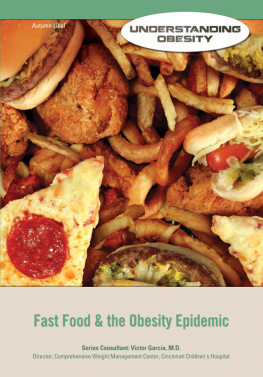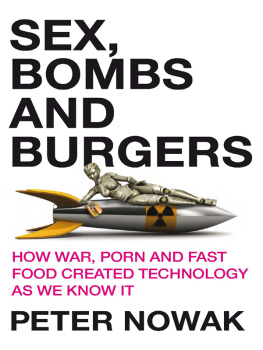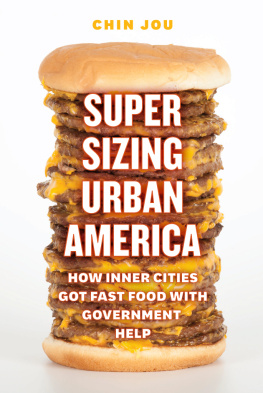ANDREW F. SMITH
No part of this publication may be reproduced, stored in a retrieval system, or transmitted, in any form or by any means, electronic, mechanical, photocopying, recording or otherwise, without the prior permission of the publishers
Page references in the Index match the printed edition of this book.
INTRODUCTION
T he single most influential culinary trend of our time is fast food. It has spawned an industry that has both changed eating, the most fundamental of human activities, and created a model that works everywhere. There are 240,000 fast-food restaurants in the United States alone and a million outlets worldwide. At the heart of the industry is a score of large multinational corporations, most of which originated in the U.S. Fast-food stores are ubiquitous, located in branded stand-alone structures, urban storefronts, military bases, shopping malls, food courts, strip malls, gas stations, railway stations, airports, department stores, zoos, supermarkets and even schools and hospitals. They offer sufficiently appetizing meals at prices hundreds of millions of diverse people throughout the world can afford. Patrons need only order, gulp and go: no dressing up, no conversation, no preparation, no tipping and no clean-up.
The industrys huge global success and its high visibility have made multinational fast-food chains easy targets for a multitude of critics who voice thoughtful concerns. Appalled by the enormous effect of fast-food culture on human, animal and environmental health, critics havepublished scathing exposs, supported boycotts, engaged in demonstrations and lobbied political leaders to force fast-food corporations to reduce the harm they cause.
The main purpose of this book is to examine controversies related to the fast-food industry. These include the issues surrounding the industrys globalization, the nutritional quality and healthfulness of its food and beverages, its mass marketing targeted at children and adolescents, its effect on the environment and its massive influence on meat production and on the way the industry treats its workers.
Globalization controversies are discussed in . Critics proclaim that fast-food chains represent bloated American lifestyles and the Americanization of the worlds cuisines. They fear for the survival of centuries-old local, regional, national and ethnic cuisines. They decry the decline of traditional restaurants and local family farms. They also note that the fast-food industry has promoted the industrialization of agriculture, with vast factory farms and feedlots now dominating food production in much of the world. Culinary leaders of the Slow Food movement have charged the industry with global culinary homogenization and the global destruction of indigenous foodways.
Fast-food chains have come under severe criticism for the poor nutritional quality of their offerings: highly processed foods, many deep-fried, combined with starchy vegetables and sugary beverages. The appeal of this food relies on the lowest common denominators of taste: its fatty, sweet and salty. The fat is often highly saturated, the sugars highly refined and the sodium levels in one meal may exceed the recommended daily intake. Fruit and vegetables other than.
The fast-food industry could not have achieved its vast global reach without massive marketing campaigns, particularly those targeting children and teenagers; this is the focus of obesity rates among children in these neighbourhoods. Fast-food chains have negotiated tie-ins with producers of childrens movies and launched websites and mobile apps for kids and teenagers; the media assault is all but unavoidable. Some countries have taken steps to curtail advertising in schools and on television, but online marketing continues unabated. Theres no doubt that this kind of advertising works: sales of fast food to children have skyrocketed worldwide. According to a recent study, an estimated 33 per cent of American children and adolescents eat fast food every day. The more frequently kids eat fast food, the more likely they are to be overweight or obese.
Its not just the personal health of fast-food consumers that is at risk. examines controversies related to the fast-food industrys effects on the environment. For decades environmentalists have charged the industry with producing excessive unrecyclable waste. The suppliers of ingredients used in fast food also come under fire: the rise in large animal feeding operations throughout the world has polluted the air, water and soil, destroyed tropical rainforests and promoted global warming. Despite mitigation measures taken by the industry and its suppliers, the overall environmental harm it has caused, directly and indirectly, continues to mount worldwide.
Animal-rights advocates, vegetarians and vegans have decried the abuse of cattle, pigs and poultry by fast-food suppliers, controversies that are covered in A series of meat-related scandals has plagued the industry. These include the use of beef flavouring in McDonalds french fries, pink slime in American hamburgers, horsemeat in European hamburgers and stinky beef in China. Then there are widespread outbreaks of food poisoning from undercooked minced beef or employees failing to follow proper sanitation procedures. Medical professionals have long argued that we should reduce our consumption of meat, especially red meat. Those engaged in combating world hunger have long protested that the massive quantities of grain used to feed animals for fast food could be employed much more efficiently as a primary food for feeding the world today and the world of tomorrow, which will have two to three billion more people by 2050.
A major reason for fast foods financial success has been the low wages paid to restaurant workers, millions of whom are employed at outlets and millions more at the farms and plants that supply the chains. Most fast-food workers receive the minimum wage and have no medical insurance, sick leave, family leave or childcare benefits. Their schedules are subject to the whims of their supervisors. Many workers are injured on the job and fall victim to crime because they work late into the night. In the U.S. alone 52 per cent of fast-food workers receive public assistance, costing American taxpayers an estimated $7 billion annually; ironically much of it is in the form of food assistance. Fast-food workers in the U.S. and elsewhere have begun to protest against their low wages and poor working conditions, but so far, only minimal changes have resulted. The workers employed by fast-food suppliers, such as meat-processing plants, suffer even more.
The final chapter looks towards the future, examining the industrys options and those of its customers, and asks what society as a whole can and should do to ameliorate the major problems generated by the fast-food industry.




















